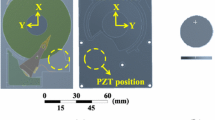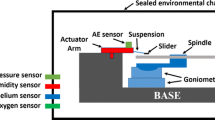Abstract
Achieving ultra-high magnetic-recording density in hard disk drives (HDDs) requires clarification of flow-induced vibration issues. In particular, it is necessary to reduce the flow-induced disk vibration called disk flutter. Thus far, however, there has been no experimental research related to disk flutter in actual HDDs. For this study, therefore, the disk-flutter issues have been studied experimentally, using an actual 2.5-in. HDD with one disk and two magnetic heads. The aim was to study the effect of operating magnetic-head mechanisms on flow-induced disk flutter. This study evaluated disk flutter as well as static pressure distribution in the actual HDD, by taking measurements while changing the operating modes of the magnetic-head mechanism as well as the number of operating air-bearing sliders. The study demonstrated that the disk-flutter amplitude increases and its frequency decreases when the magnetic-head mechanisms are operating. It was also found that the amount of decrease in the disk-flutter frequency depends on the number of operating air-bearing sliders whose amplitude increase varies with the specific operating mode of the head mechanisms, such as whether it is in track-following or seek modes. In addition, operation of the magnetic-head mechanisms generated non-uniform static pressure distribution within the HDD. These factors suggest that a decrease in disk-flutter frequency results from the slider-coupled vibration and an increase in disk-flutter amplitude results from the static pressure changes as well as air-following changes, as these vary with the actual operation of the disk head mechanism. From these experimental results, it appears that the disk-flutter issues in actual HDDs should be considered as a system that includes the operation of the magnetic-head mechanisms and disk-coupled vibration.











Similar content being viewed by others
References
Fukaya R, Obi S, Masuda S, Tokuyama M (2002) Flow instability and elastic vibration of shrouded corotating disk systems. Exp Fluids 33:369–373
Heo B, Shen IY (2001) Pressure maps of Velcro treatments to reduce aerodynamic disk flutter at high spin speed. In: Proceedings of the ASME information storage and processing systems conference 2001 (2001–2006)
Heo B, Shen IY, Riley JJ (2001) Reducing disk flutter by improving aerodynamic design of base casings. IEEE Trans Magn 36(5):2222–2224
Herrero J, Giralt F, Humphrey JAC (1999) Influence of the geometry on the structure of the flow between a pair of corotating disks. Phys Fluids 11(1):88–96
Humphrey JAC, Li H, Schuler CA (1991) Unobstructed and obstructed rotating disk flows: a summary review relevant to information storage systems. Adv Inform Storage Syst 1:79–110
Imai S (2001) Fluid dynamics mechanism of disk flutter by measuring the pressure between disks. IEEE Trans Magn 37(2):837–841
Imai S, Tokuyama M, Yamaguchi Y (1999) Reduction of disk flutter by decreasing disk-to-shroud spacing. IEEE Trans Magn 35(5):2301–2303
McAllister JS (1996) The effect of disk platter resonances on track misregistration in 3.5 inch disk drives. IEEE Trans Magn 32(3):1762–1766
Ono K, Maeda E (2000) Suppression of disk flutter by a squeeze air bearing plate. J Inform Storage Proc Syst 2:33–40
Shen IY, Ku C-PR (1995) On the vibration analysis of multiple rotating flexible disks. Adv Inform Storage Syst 1:259–270
Takada S, Tagawa N, Mori A, Mizoh Y, Nakakita M (2006) Study on flow induced vibration of head disk assembly mechanisms with high speed rotating disks (1st report). Trans Jpn Soc Mech Eng Ser C 72:22–29 [in Japanese]
Acknowledgments
The present work was supported in part by the Kansai University High-Tech Research Center’s Project: the development of the innovative nanotechnology for the Tbit class ultra high density information storage systems supporting the ubiquitous society, 2005–2009.
Author information
Authors and Affiliations
Corresponding author
Rights and permissions
About this article
Cite this article
Takada, S., Kusukawa, T., Tagawa, N. et al. Study on flow-induced vibration of head–disk assembly mechanisms in actual hard disk drive. Microsyst Technol 13, 767–775 (2007). https://doi.org/10.1007/s00542-006-0279-8
Received:
Accepted:
Published:
Issue Date:
DOI: https://doi.org/10.1007/s00542-006-0279-8




